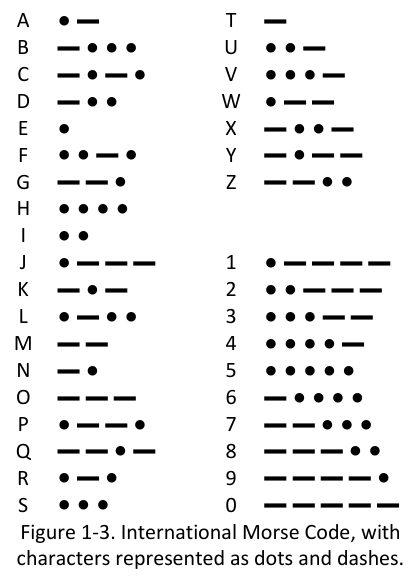
document.querySelector('video').playbackRate = 1.2“The original idea of the web was that it should be a
collaborative space,
where you can communicate through sharing information.”
- Tim Berners-Lee
(One person often credited with inventing much of the internet as we
know it)
https://en.wikipedia.org/wiki/Tim_Berners-Lee
https://en.wikipedia.org/wiki/Morse_code

https://www.youtube.com/watch?v=7R9bHJfymjg&list=PLtaR0lZhSyAPLuoSbMA29s3Ry8ZUvKff3&index=11
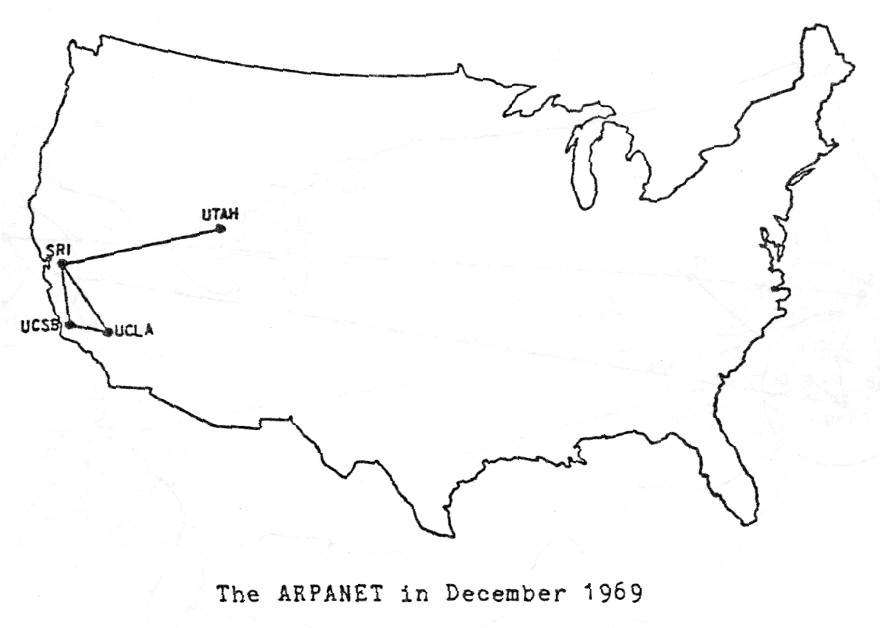
https://en.wikipedia.org/wiki/ARPANET
ARPANET, the precursor to the modern internet,
was an academic research project funded by the Advanced Research
Projects Agency,
a branch of the military known for funding ambitious research
projects,
without immediate commercial or military applications.
Initially, the network only connected the University of Utah,
with three research centers in California.
ARPANET was a test of a then-novel technology called
packet-switching,
which breaks data into small “packets”,
so they can be transmitted efficiently across the network.
It also had a more practical goal:
allowing more efficient use of expensive computing resources.
Computer scientists sometimes used ARPA money to buy computers,
and the agency hoped that ARPANET would allow universities to share
these expensive resources more efficiently.
One of the first ARPANET
applications was Telnet,
which allowed a researcher at one ARPANET site to log into a
computer at another site.
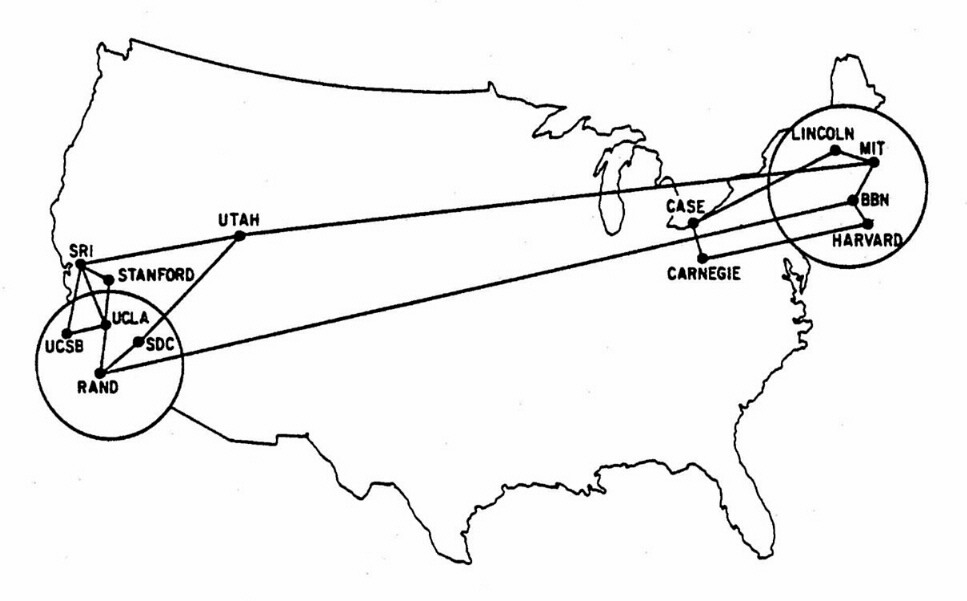
By the end of 1970, ARPANET had grown to 13 nodes,
including East Coast schools like Harvard and MIT.
Among the early nodes was Bolt, Beranek, and Newman (BBN),
an engineering consulting company that did the engineering work required
to build ARPANET.
Each ARPANET site had a router known as an
Interface Message Processor.
These cost $82,200, or half a million dollars in today’s money.
A window into the way of thinking about things in 1972:
https://www.youtube.com/watch?v=I_pj-4cPBW8
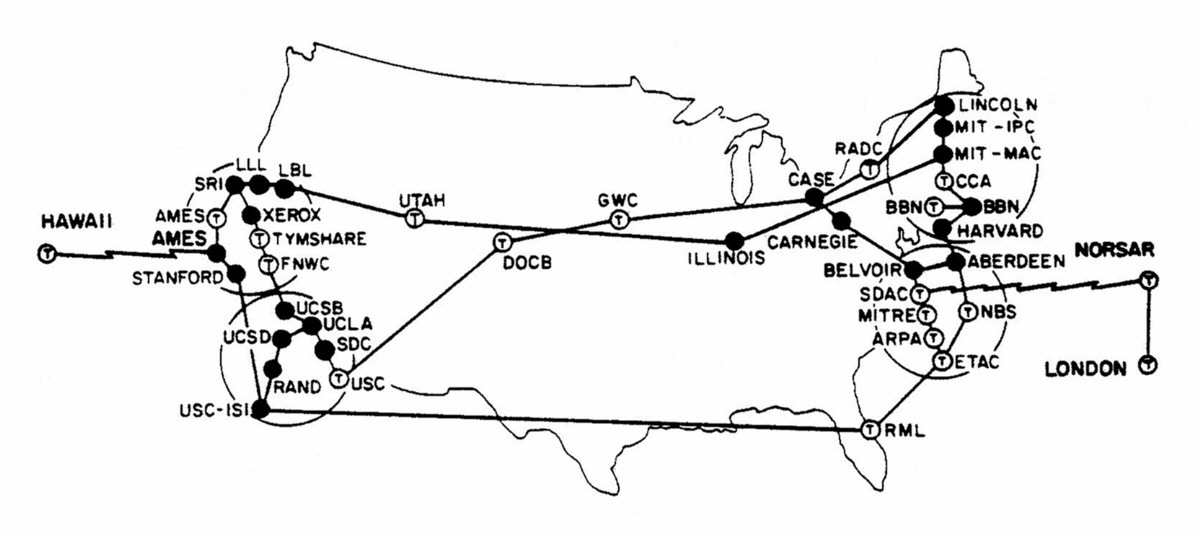
In 1973, the ARPANET became international,
with a satellite link connecting Norway and London to the other nodes in
the United States.
Hawaii also joined the network by satellite.
At this point, the network had around 40 nodes.
New ARPANET applications had begun to emerge:
Email was invented in 1971 by a BBN engineer named
Ray Tomlinson,
who also invented the use of the “@” symbol in email addresses.
The File Transfer Protocol, which is still used
today,
allowed ARPANET users to send files to each other.
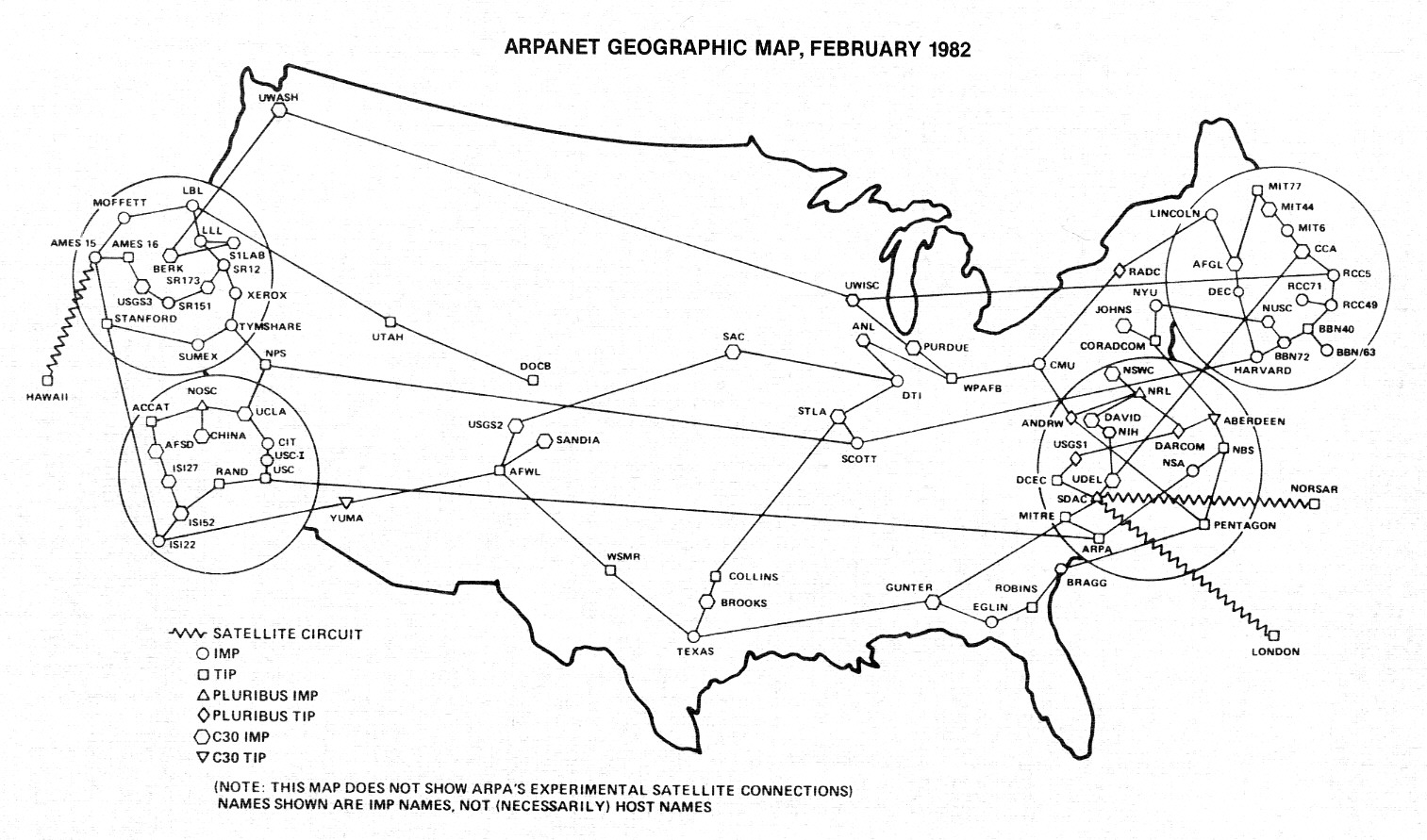
As ARPANET entered its second decade,
it was still largely confined to the United States.
Academic institutions depended on federal funding to join the
network,
so the number of nodes expanded slowly.
By 1982, the network only had about 100 nodes.
But that was enough to support a vibrant online community.
Long before Facebook and Twitter,
ARPANET allowed computer scientists who had access to the network to
stay in touch.
A new bulletin board system called Usenet was invented
in 1980 and caught on quickly.
Usenet was organized by topic, allowing users to:
swap programming tips, recipes, jokes, opinions about science fiction,
and much more.
Arguing on the internet has an ancient history…
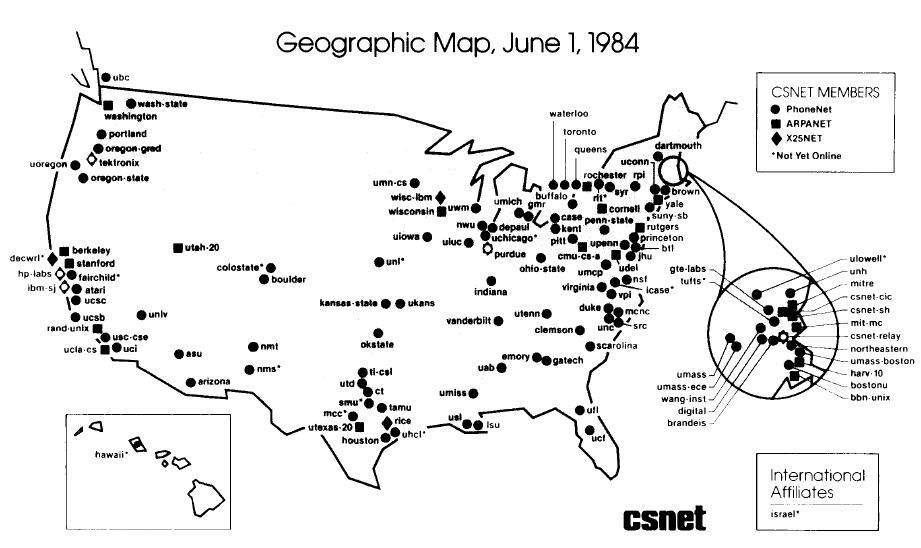
https://en.wikipedia.org/wiki/Hosts_%28file%29
Computers need numeric addresses, but
it is hard for humans to remember which human owns which numeric
address,
The ARPANET, the predecessor of the Internet,
had no distributed host name database.
Originally a file named HOSTS.TXT was manually
maintained,
and made available via file sharing by Stanford Research Institute for
the ARPANET membership,
containing the hostnames and address of hosts as
contributed for inclusion by member organizations
Each network node maintained its own map of the network
nodes as needed,
and assigned them names that were memorable to the users of the
system.
There was no method for ensuring that all references,
to a given node in a network, were using the same name,
nor was there a way to read the hosts file of another computer,
to automatically obtain a copy.
The small size of the ARPANET kept the administrative overhead
small,
to maintain an accurate hosts file.
Network nodes typically had one address and could have many names.
As local area TCP/IP computer networks gained popularity,
the maintenance of hosts files became a larger burden on system
administrators,
as networks and network nodes were being added to the system with
increasing frequency.
The Domain Name System (DNS), first described in
1983 and implemented in 1984,
automated the publication process,
and provided instantaneous and dynamic hostname resolution,
in the rapidly growing network.
In modern operating systems, the hosts file remains an alternative
name resolution mechanism,
configurable often as part of facilities such as the Name Service
Switch,
as either the primary method or as a fallback method.
Originally, the entire ARPANET was managed by the military.
But network operators realized that a centralized network would
eventually become unmanageable,
if it continued to grow.
They decided that the network should be reorganized as a decentralized
“network of networks.”
Under this scheme, different networks would be controlled by different
organizations,
but all the networks able to communicate using shared
standards,
forming a shared “internet.”
The military called on the computer scientists Robert Kahn and Vint
Cerf,
to develop new networking standards to make this possible.
The result was a set of standards known as
TCP/IP.
These standards specified the basic format of data
packets transmitted across the internet.
On January 1, 1983, the ARPANET switched to using TCP/IP,
marking the birth of the modern internet!
The switch to TCP/IP didn’t make much difference from a user
perspective,
since applications like email and Telnet worked about the same as they
had before.
But the new standard paved the way for much faster network growth,
by lowering the barrier to entry for new networks.
One of the first new networks to connect to the new internet was
CSNET,
which was funded by the National Science Foundation,
to link computer science departments across the country.
This map shows the location of ARPANET and CSNET nodes (labeled
“Phonenet”),
which after 1983 communicated with each other using TCP/IP.
By the time the ARPANET was decommissioned in 1990,
it was just one of many networks that comprised the internet.
Today (when this was written), the internet is made up of more than
40,000 different networks.
These networks still communicate with each other using the
TCP/IP standards,
similar to those that Cerf and Kahn developed in the 1970s.
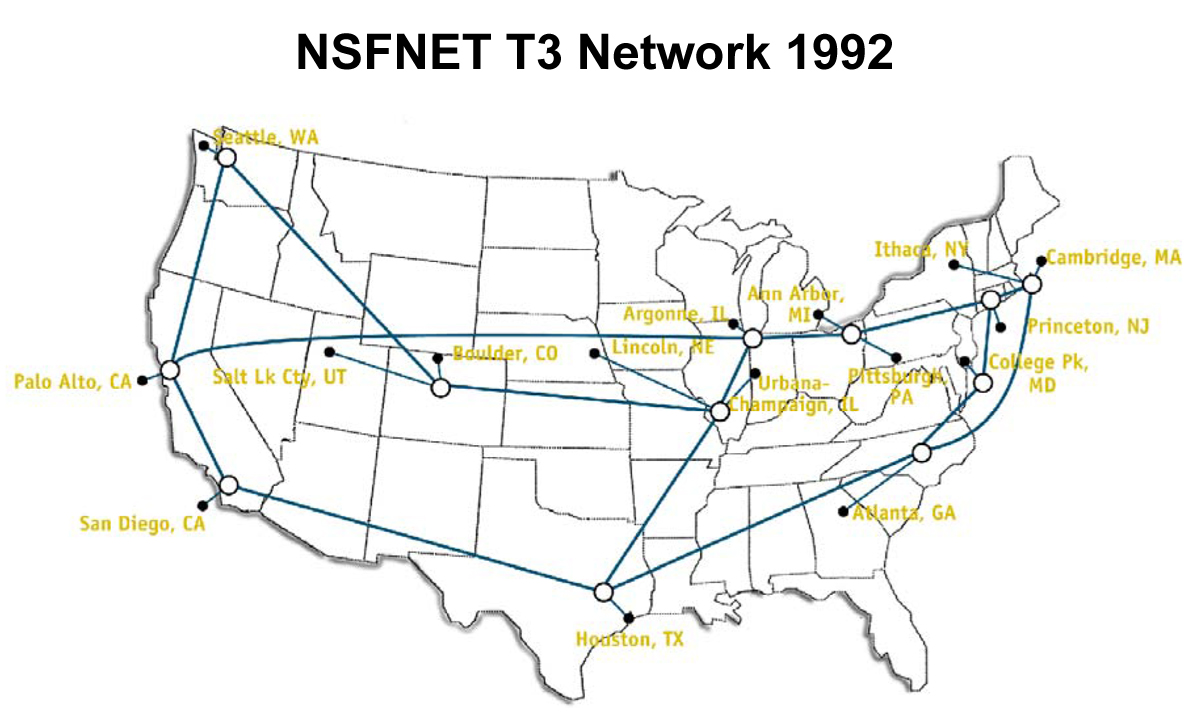
During the 1980s, the National Science Network funded several
super-computing centers around the United States.
And in 1986 the agency created a TCP/IP-based network called
NSFNET,
to link those super-computing centers together,
and allow researchers across the country to use them.
The primary goal was science,
to allow computer science researchers to remotely log onto the
supercomputers,
and perform academic research.
But NSF decided not to limit NSFNET to that purpose,
allowing the network to be used for a wide variety of academic
purposes.
As a result, the NSFNET became the internet’s “backbone”,
the high-speed, long-distance network that allowed different
parts of the internet to communicate.
Schools that didn’t have a direct connection to the NSFNET,
worked together to build regional networks,
that linked them to each other, and to the nearest NSF node.
This shows the NSFNET as it existed in 1992.
By this time, there were 6,000 networks connected to NSFNET,
with a third of them located overseas.
That meant that students and faculty at a growing number of
universities had access to:
email, Usenet, and even a recently-invented application called
the World Wide Web!
And although the NSFNET was officially restricted to non-commercial
use,
for-profit companies were increasingly connecting to the network as
well,
setting the stage for the commercialization of the internet that
followed.
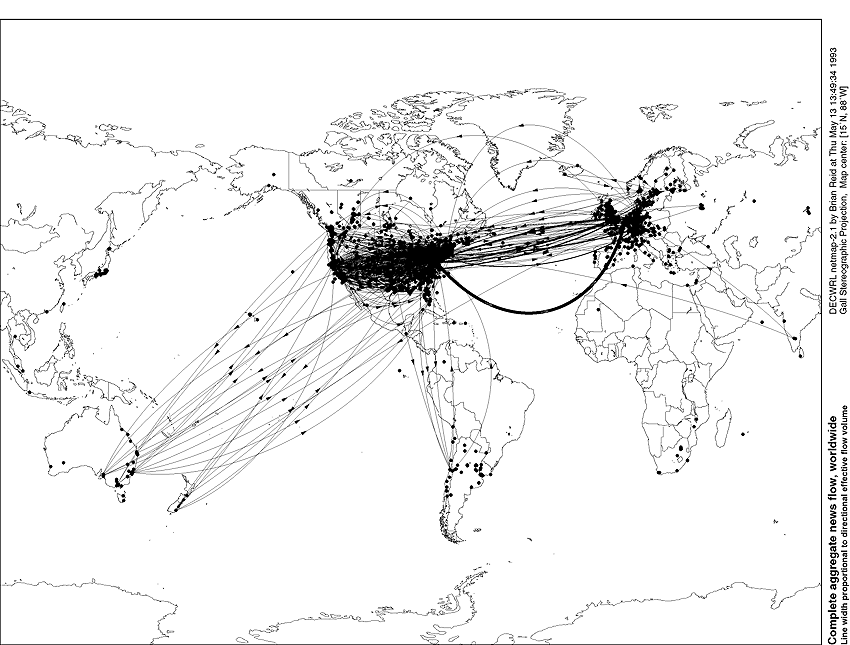
In 1993, the internet was still dominated by the United
States,
but it was becoming a truly global network.
Above is a map of information flow on Usenet,
an bulletin board application that allowed users to swap
information,
recipes, jokes, programming tips, and more.
https://en.wikipedia.org/wiki/Preferential_attachment
causes early nodes to tend to stick around and creates a:
https://en.wikipedia.org/wiki/Power_law
distribution of degree in nodes.
This is the reason “the rich get richer”;
it is a more general form of emergent phenomenon.
What has this done for the USA’s role in the internet?
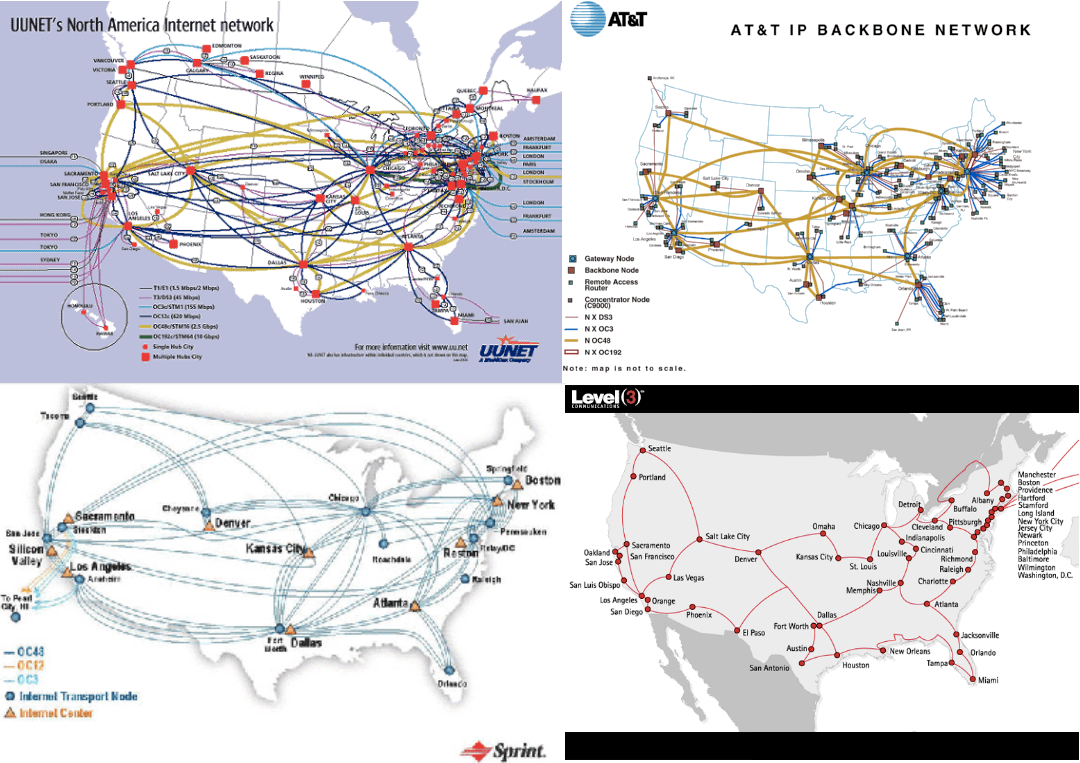
In 1994, the Clinton Administration further facilitated the
privatized the internet backbone.
Commercial firms took over the job of carrying long-distance
internet traffic,
allowing the government-funded NSFNET to be decommissioned (how
generous…).
Officials were careful to ensure that no single company controlled too
much of the backbone,
helping to create a competitive market for internet connectivity
that still exists today.
Lol…
The above four maps illustrate how the market had evolved by the turn
of the century.
Four of the largest private long-distance network providers were UUNet,
AT&T, Sprint, and Level 3.
Each had its own nationwide (and global) network,
and they competed with each other,
to provide long-distance connectivity to smaller networks.
UUNet became part of WorldCom in 1996, and became part of Verizon in
2006.
Today, Verizon operates one of the world’s largest internet
backbones,
in competition with AT&T, Sprint, Level 3 and many other
companies.
https://neal.fun/internet-artifacts/
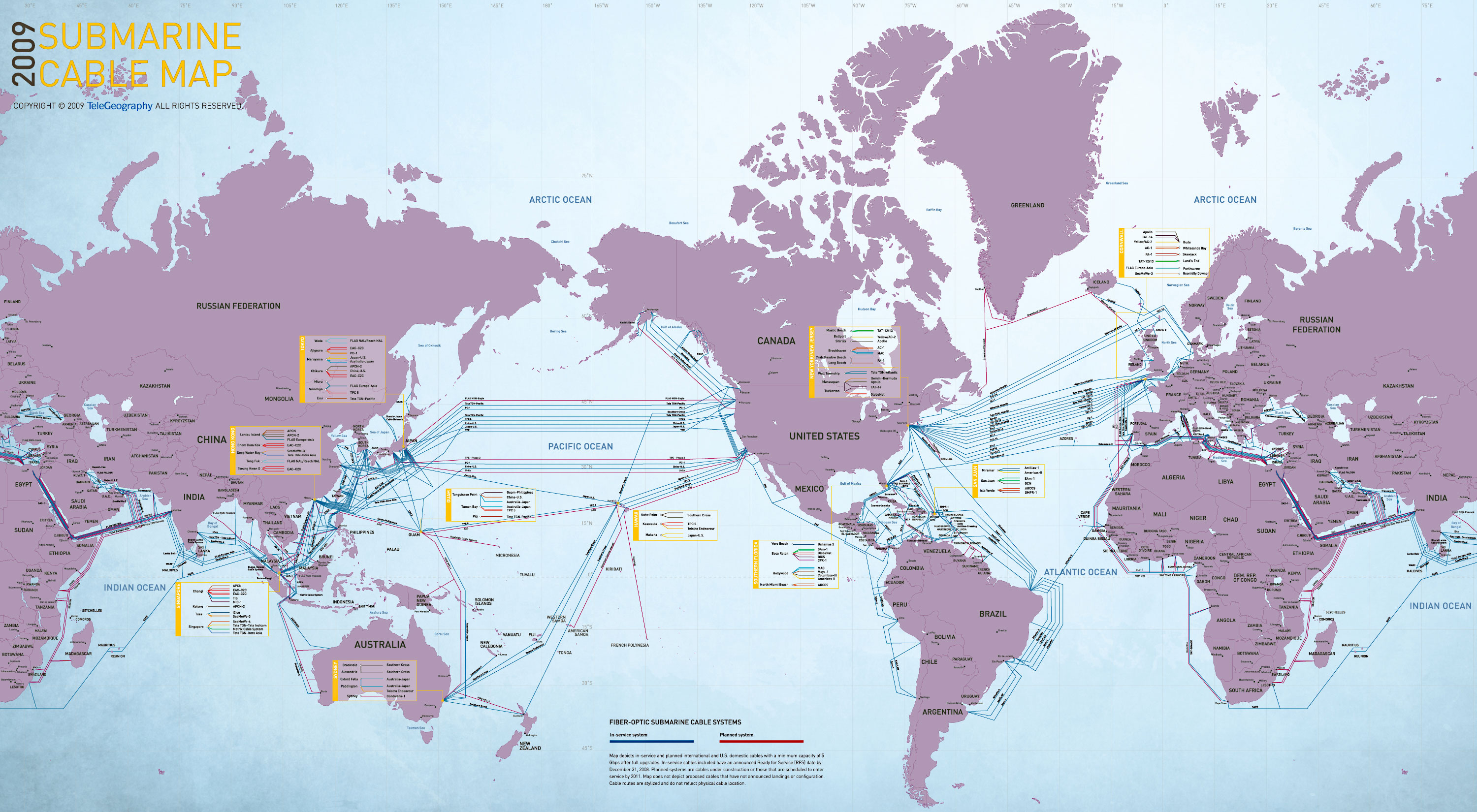
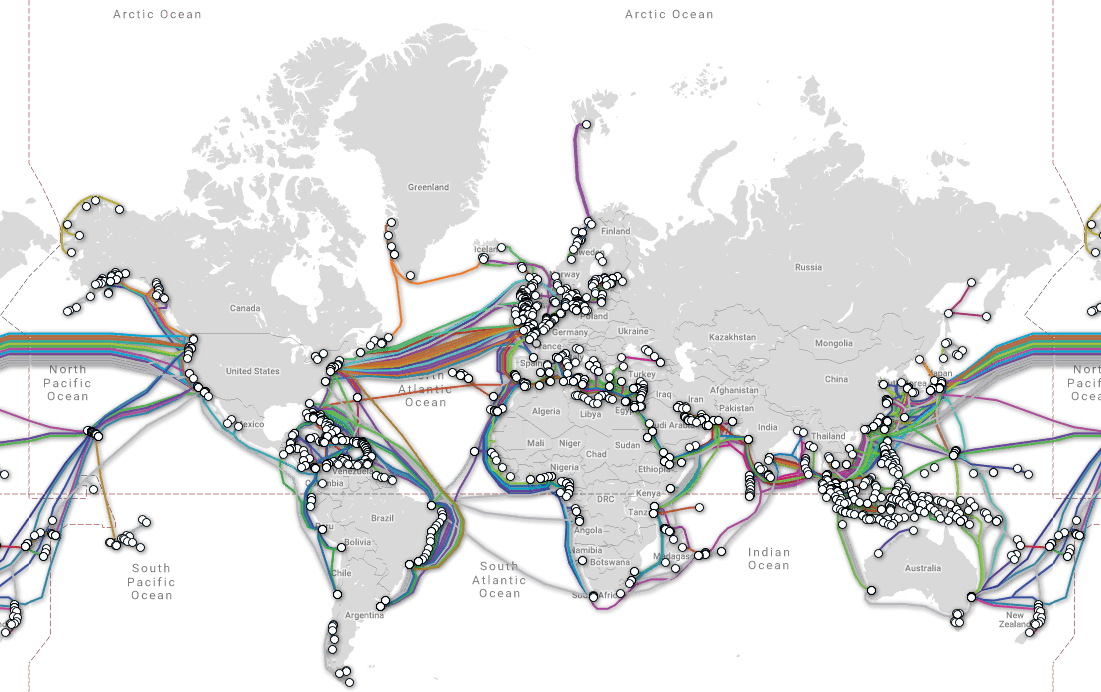
https://www.submarinecablemap.com/
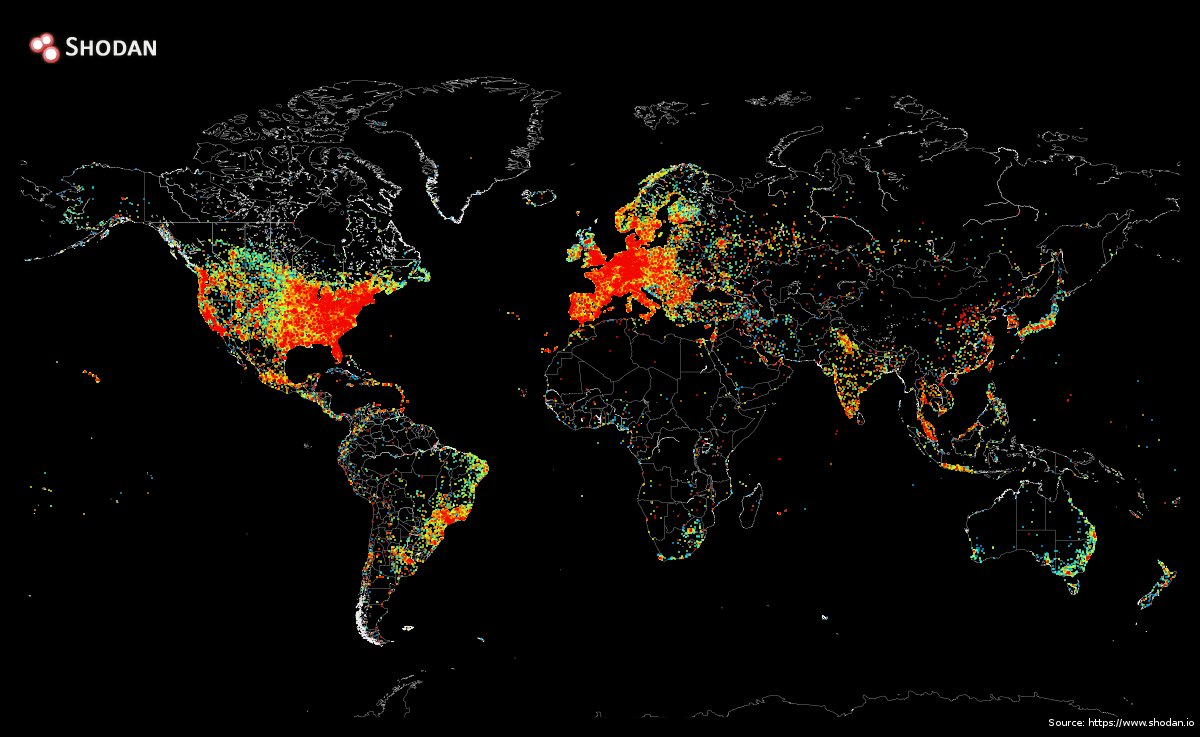
Check out all the random devices visible to the open internet
(and ready to be hacked and exploited):
https://www.shodan.io/
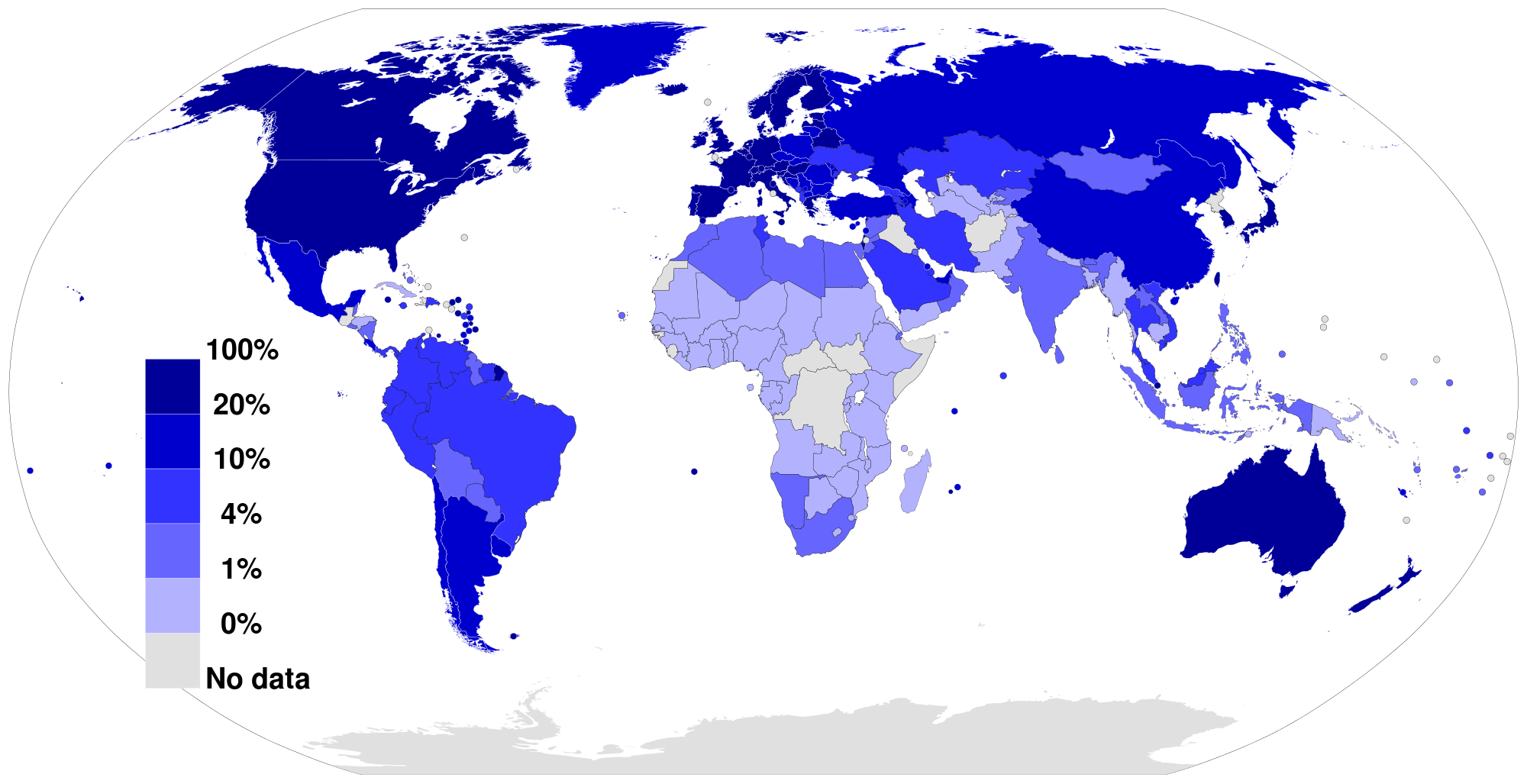
There are two primary ways people can log onto the internet:
through a fixed broadband connection at home or in an
office and
via a wireless connection, often on a cell phone or
tablet.
This image data from the International Telecommunications
Union,
shows how popular fixed internet access is around the
world.
It shows internet access is widespread in most parts of the world,
but is still fairly scarce in much of sub-Saharan Africa and the Middle
East.
Fixed internet access allows multiple devices in a customer’s home to
access the internet.
Fixed connections are also ideal for streaming-video services, such as
Netflix,
because they tend to have greater capacity than wireless networks.
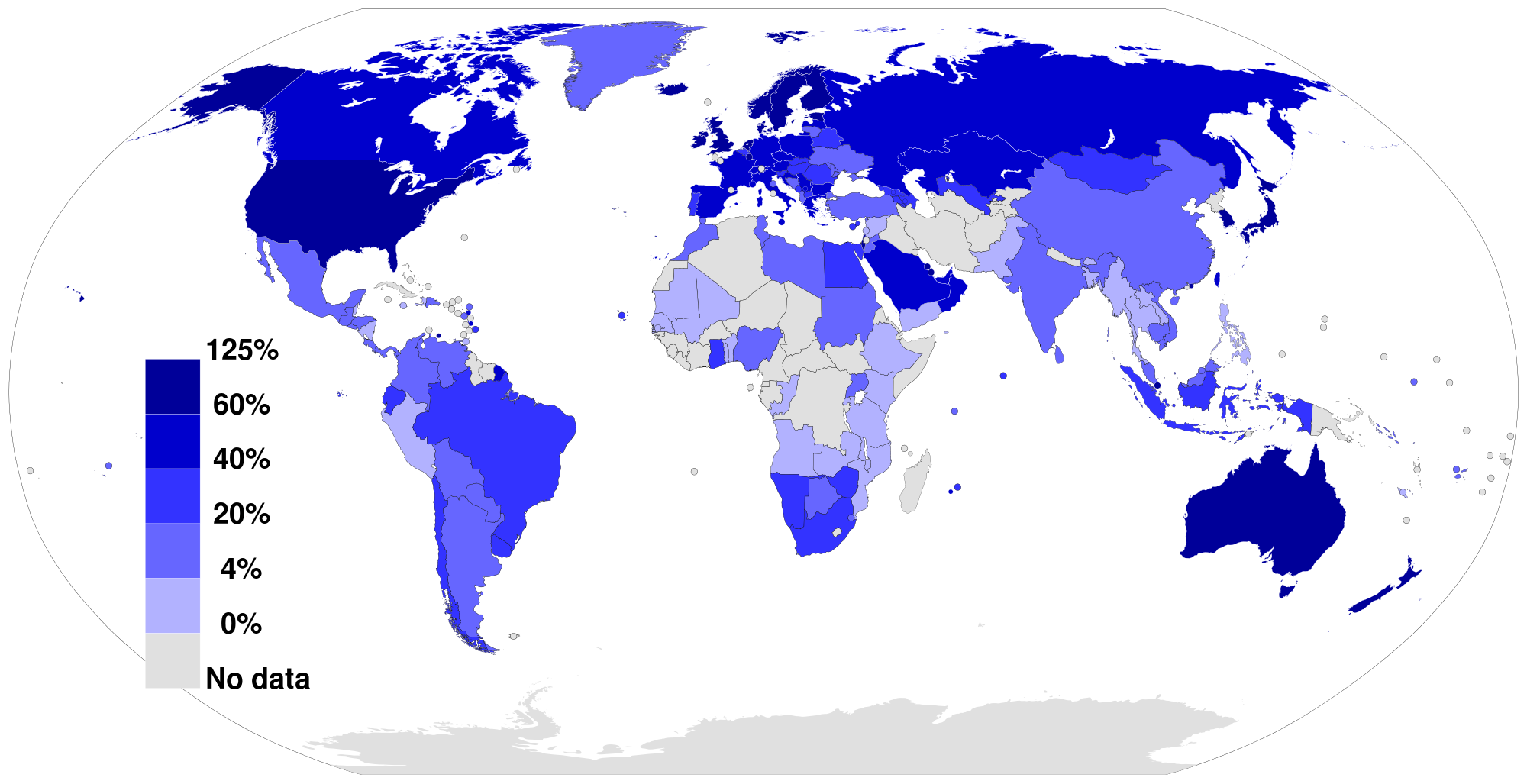
This map shows the:
percentage of consumers around the world who have mobile
internet access
(note that the colors on this map are not directly comparable to the
previous map).
In the developed world, people usually got fixed internet access
first,
and obtained mobile internet devices later.
But, some developing countries are skipping the construction of
fixed broadband networks altogether.
This is cost-effective,
because a single cell phone tower can provide service to hundreds of
customers.
For examle, at the time of this writing,
2.7 percent of Egyptians have fixed broadband service at home,
but 10 times as many Egyptians have internet access using a cell
phone.
The story is similar in Ghana, Uzbekistan, Indonesia, South Africa, and
Nigeria.
Mobile internet access can have profound implications for
people in isolated areas.
Farmers can use mobile phones to learn about recent market
developments,
increasing the amount they can get for their crops.
Some mobile phone operators also offer sophisticated payment
capabilities,
allowing people who don’t have access to the conventional banking system
to make electronic payments.
A few wealthy countries, including Japan, South Korea, and Sweden,
that have more mobile internet subscriptions than people.
Some customers have two more or smartphones, tablets,
or other connected mobile devices (imagine that).
How many internet connections do you have?
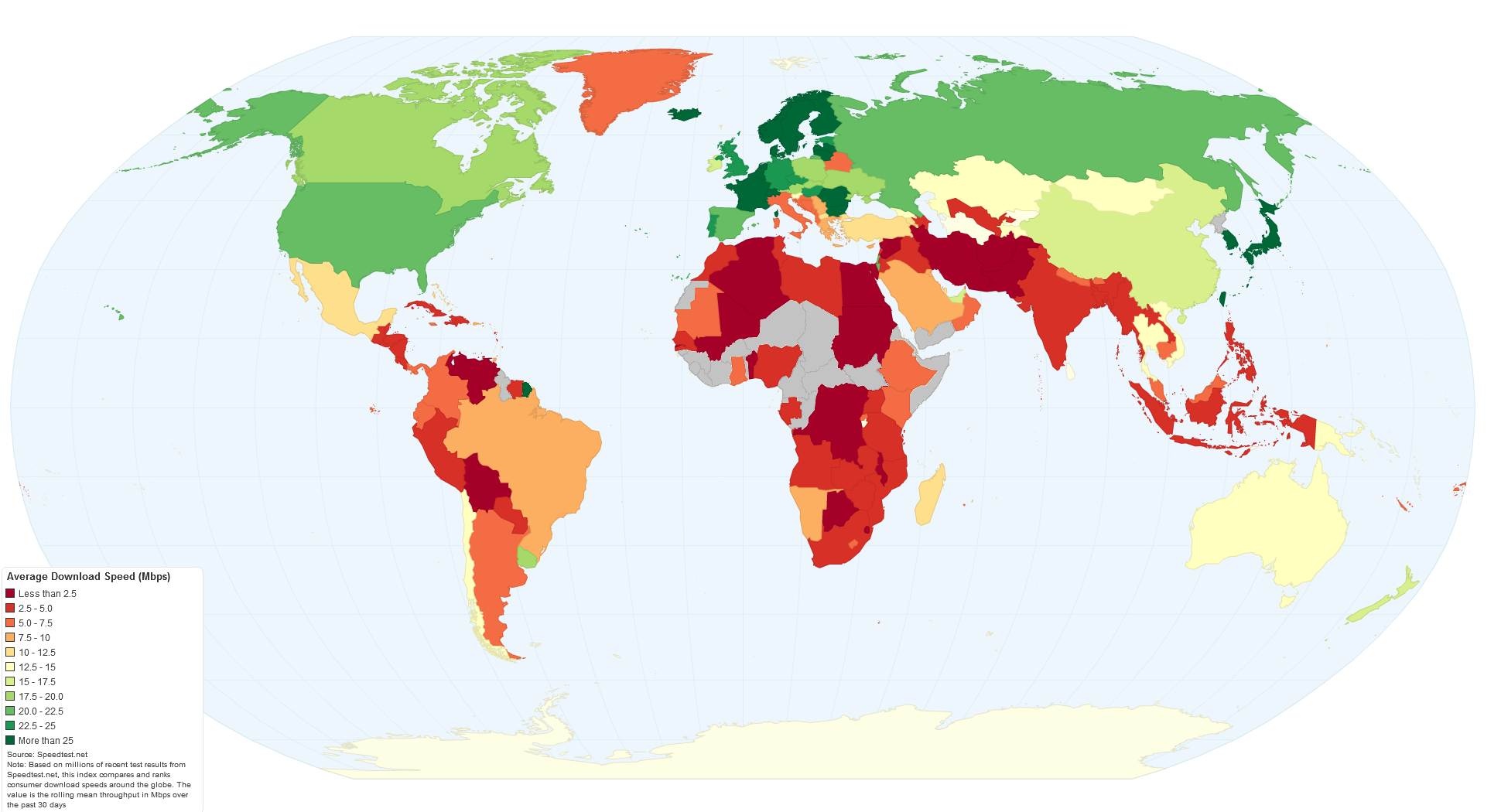
Internet access is a lot faster in some places than others.
According to Speedtest.net, a website that lets users test their own
internet connections,
the fastest internet in the world is in Hong
Kong,
with an average of almost 80 million bits per second (Mbps).
Other high-speed countries include Japan, South Korea, Sweden, Romania,
the Netherlands, and Switzerland.
The United States clocks in at number 30, with average speeds of
24 Mbps.
These figures are worth taking with a grain of salt,
because they’re based on a self-selected sample, at a timepoint in the
past.
Users must visit the speedtest.net website to test their own broadband
speeds,
and it stands to reason that users with fast connections would be most
likely to try it.
Still, the data permits interesting cross-country comparisons.
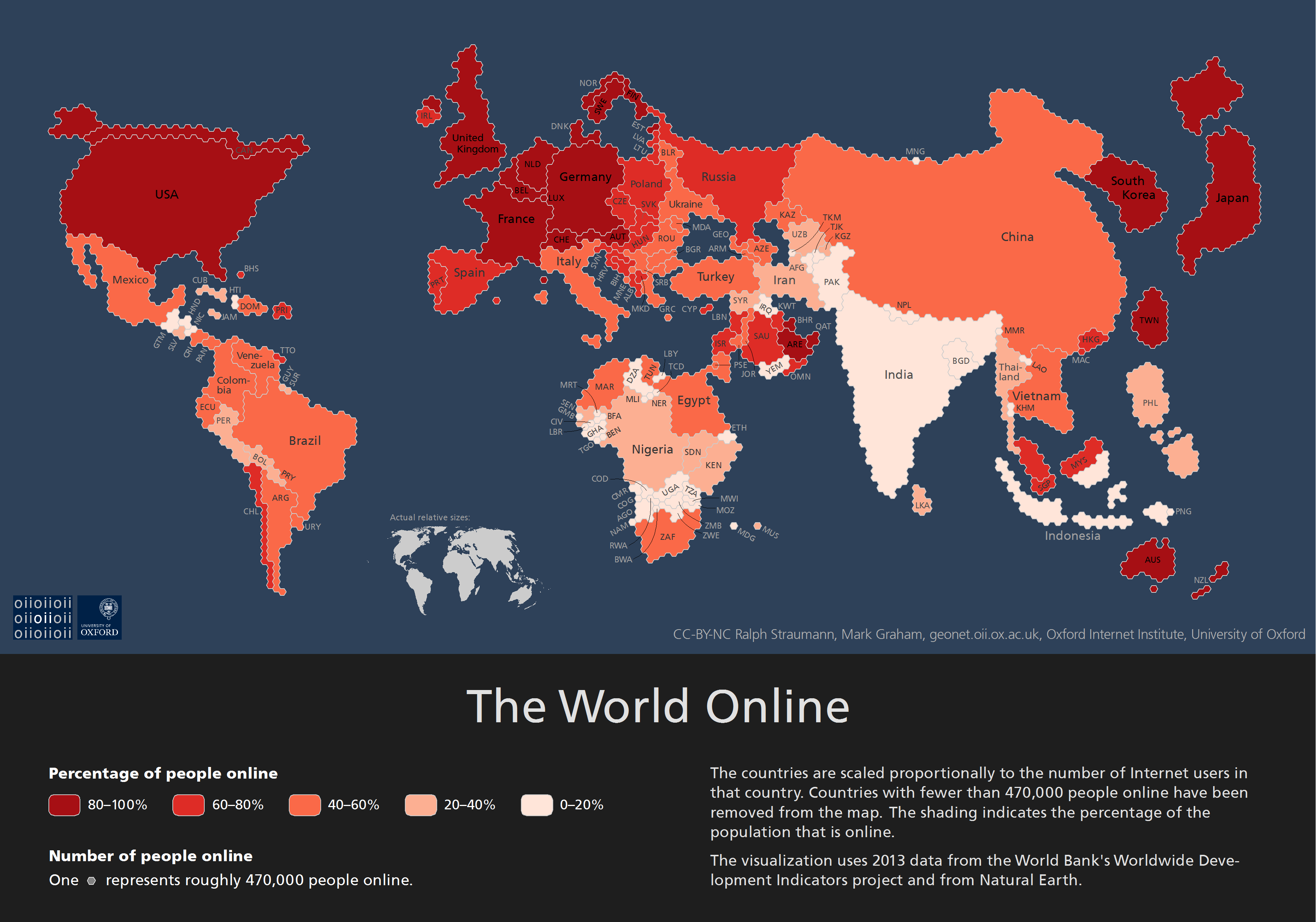
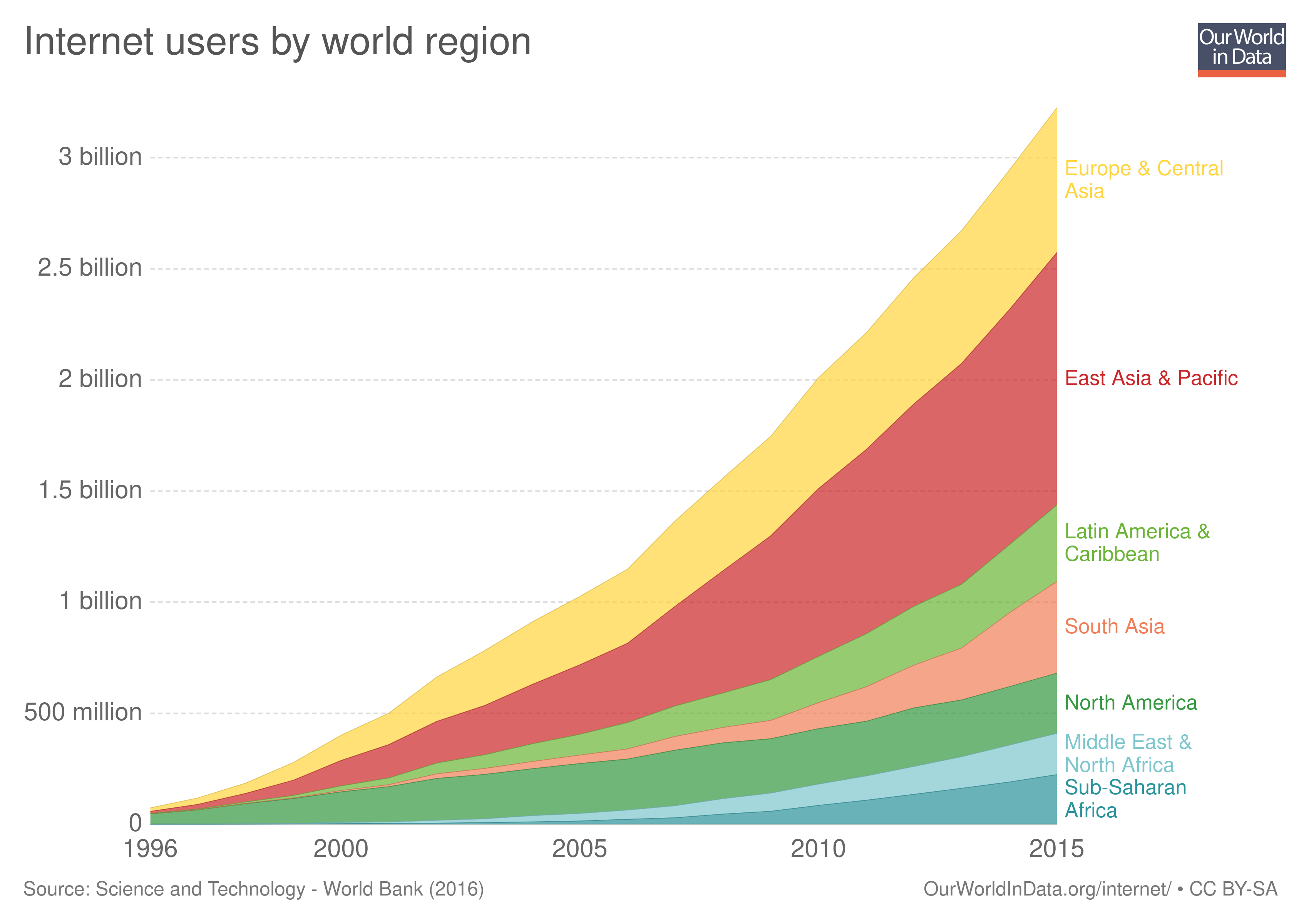

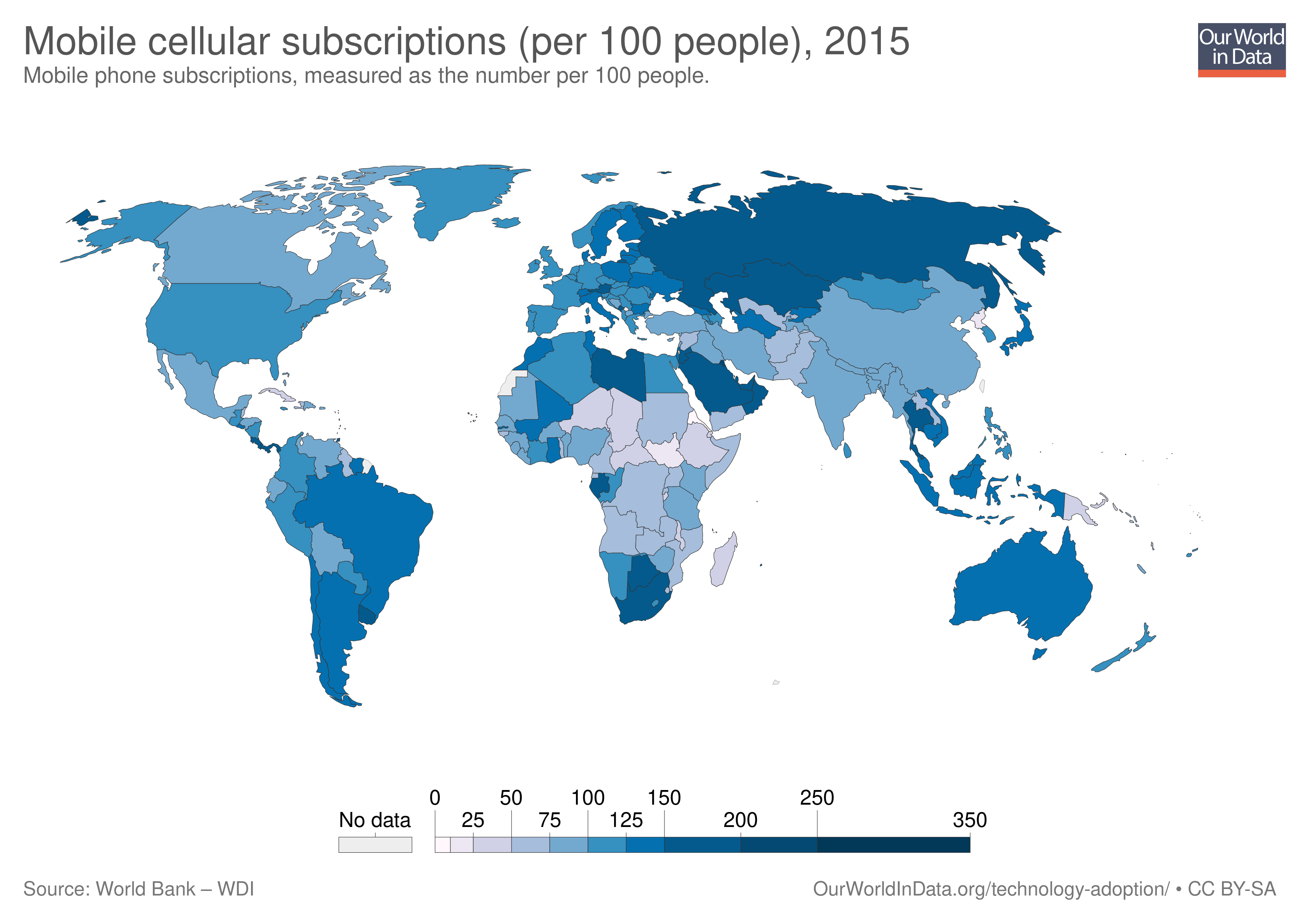
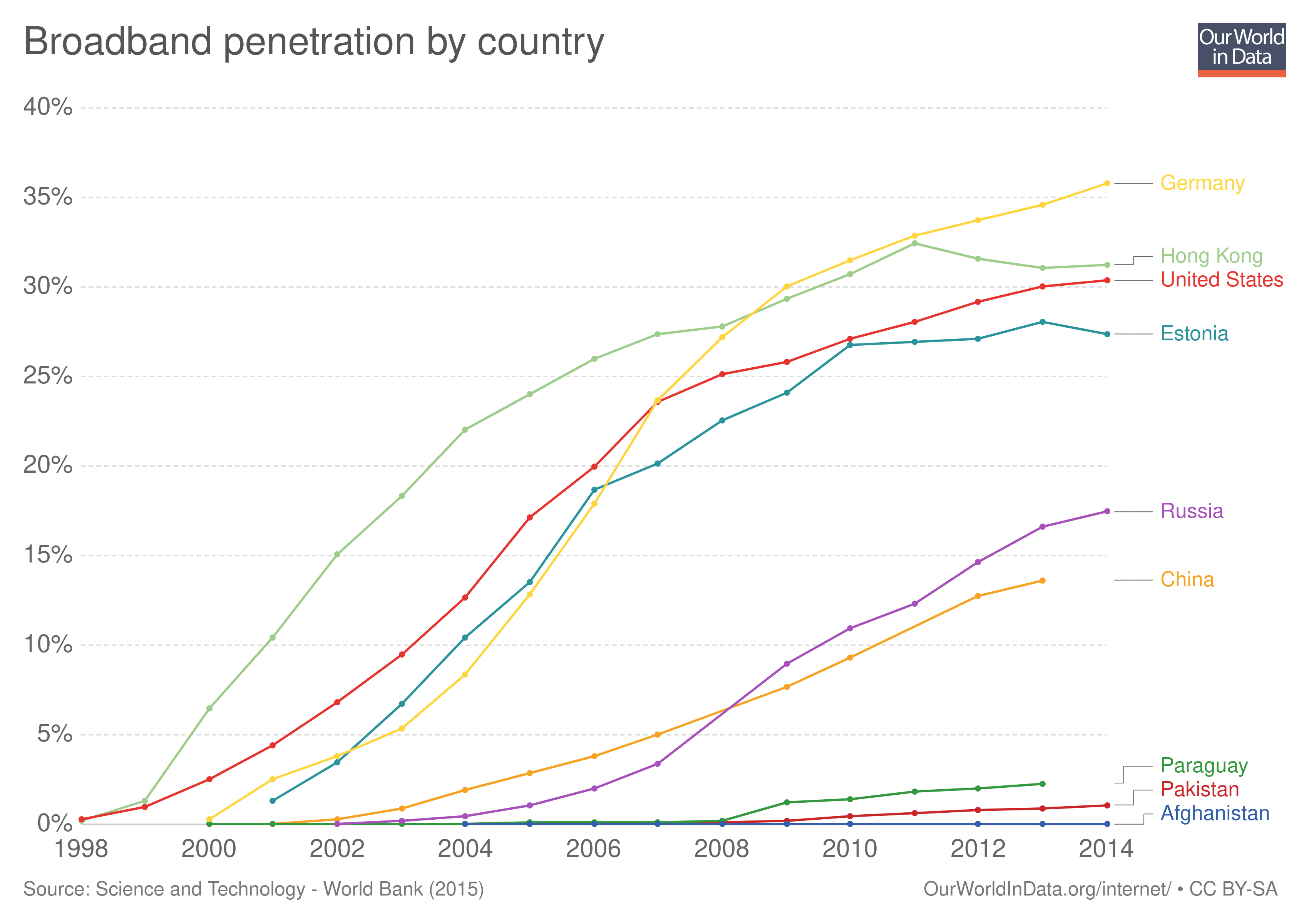
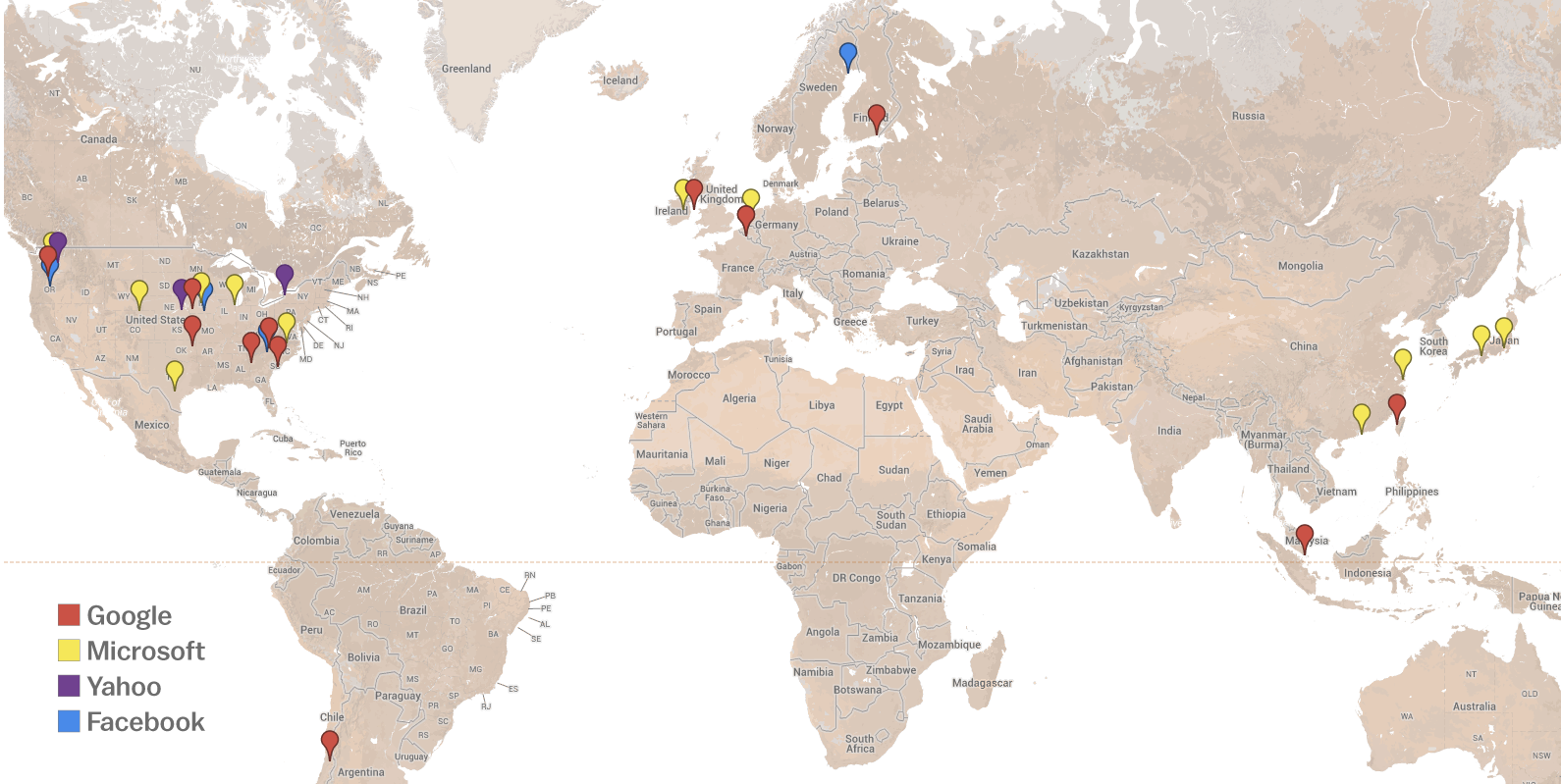
If you’ve entrusted your data to Google, Facebook, Yahoo, or
Microsoft,
then there is a good chance it’s stored at a location marked by one of
these pins.
Smaller web companies store their servers in data centers managed by
third parties,
but the internet’s largest companies have their own dedicated data
centers,
with hundreds of thousands of servers in them.
These data centers are located around the world,
distributed
That has two advantages:
First, locating data centers close to users allows data to be delivered more quickly.
Second, it helps provide redundancy:
if user data is kept in multiple locations,
then it will be safer even in the event of a catastrophic
failure at one data center.
On this map:
Google data centers are red,
Microsoft data centers are yellow,
Yahoo data centers are purple,
and Facebook data centers are blue.
This is not an exhaustive list of these companies’ facilities.
Many of these companies are secretive about their operational
details,
and so some of the companies’ data center locations haven’t been
publicly disclosed.
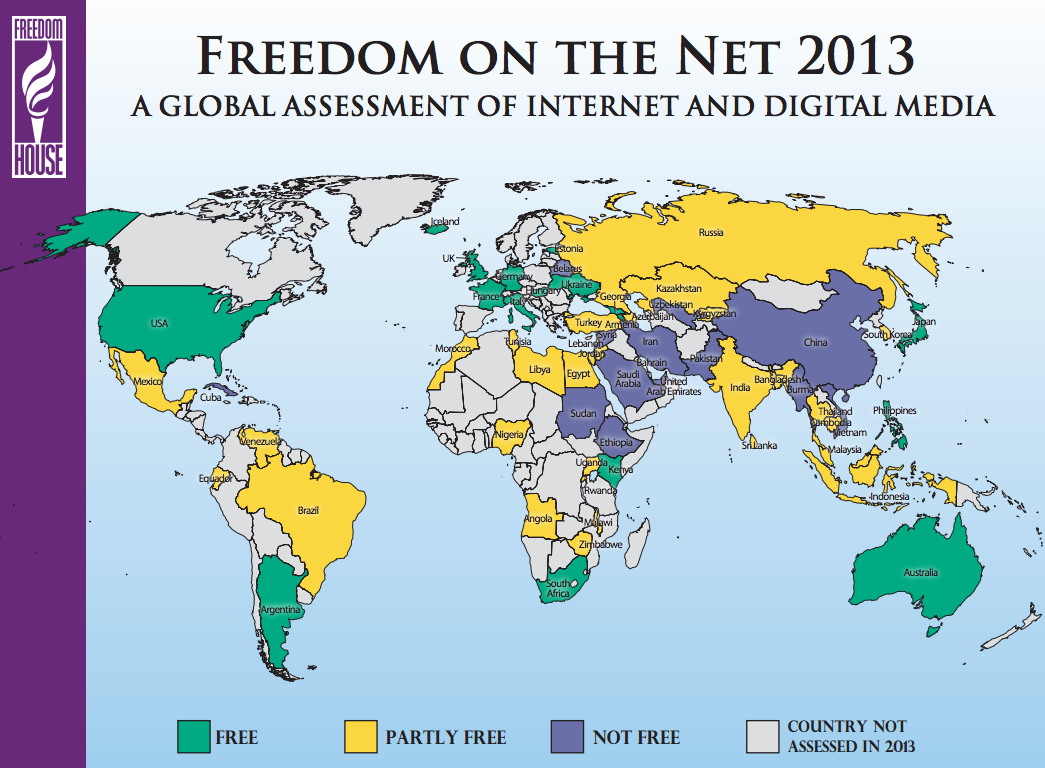
The US has law regarding free speech.
Many are surprised to find out that Europe does not,
and not so suprised to know third-world countries do not.
In most Western countries, the internet is intended as a
“free-speech” zone,
where ordinary people can express themselves without fear of
censorship.
But that’s not true everywhere, and less so as time goes on,
for example in Australia, Europe, and even the US.
This map from “Freedom House” details which countries respect freedom
of speech,
and which countries flout it.
Cuba and several countries in Southeast Asia and the Middle East / North
Afrcia (MENA)
all engage in pervasive censorship and are marked in purple.
China, for example, has a “great firewall”,
that makes it difficult for its citizens to read about sensitive
topics,
such as the Falun Gong or the 1989 Tiananmen Square massacre.
https://www.reddit.com/r/UnethicalLifeProTips/comments/b3f0d1/ulpt_if_youre_ever_doing_business_with_a_chinese/
https://www.theguardian.com/world/2018/aug/07/china-bans-winnie-the-pooh-film-to-stop-comparisons-to-president-xi
Australia partially criminalized cryptography,
though does not really use the laws.
In Russia, for example, the government has engaged in more aggressive
internet censorship,
since Vladimir Putin returned to power in 2012,
and people have been killed by the state based on their internet
presence…
Last year (2024), Brazil criminalized IP obfuscation (VPNs).
Other countries have a partially free internet (for now…).
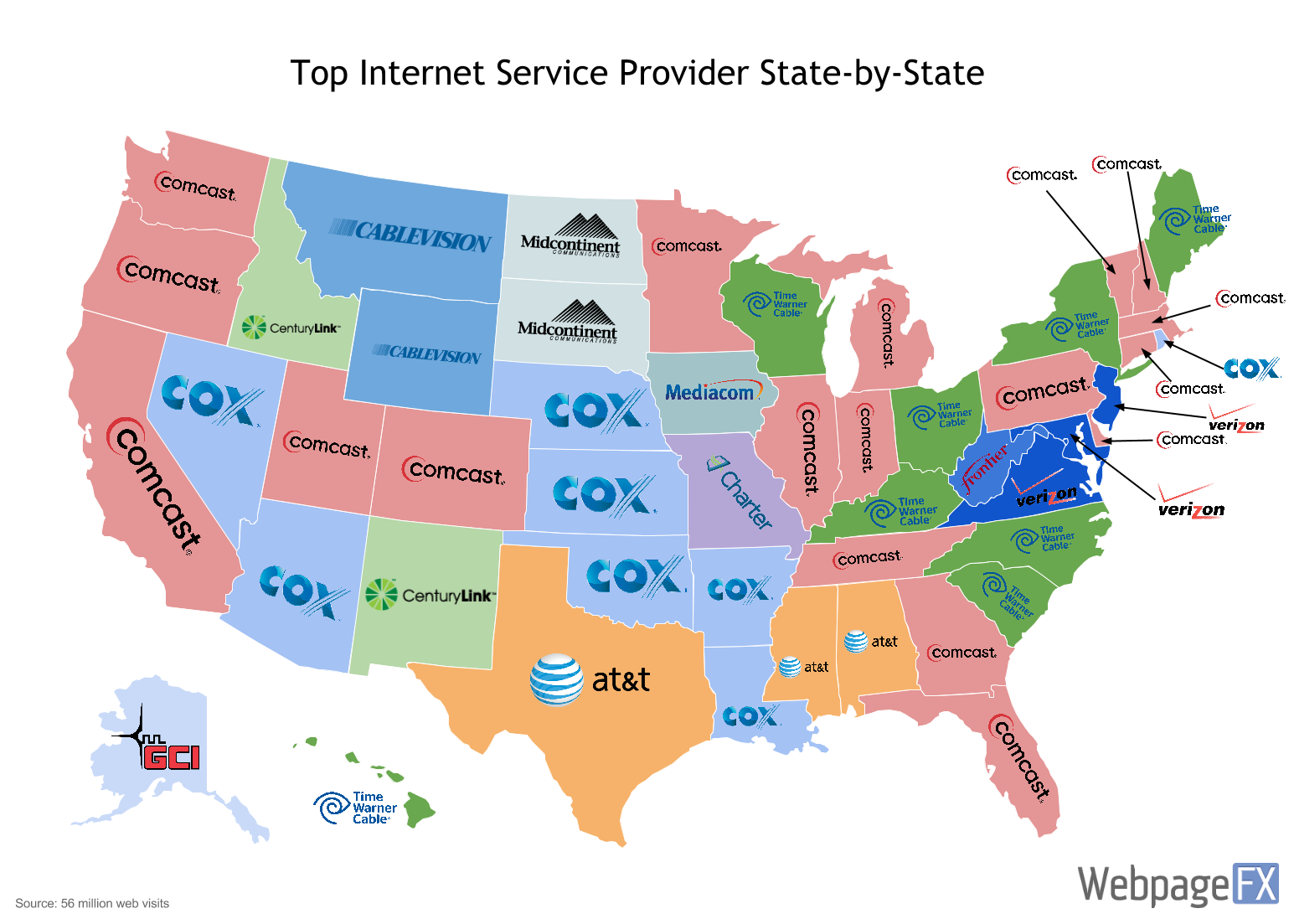
Some early predictions:
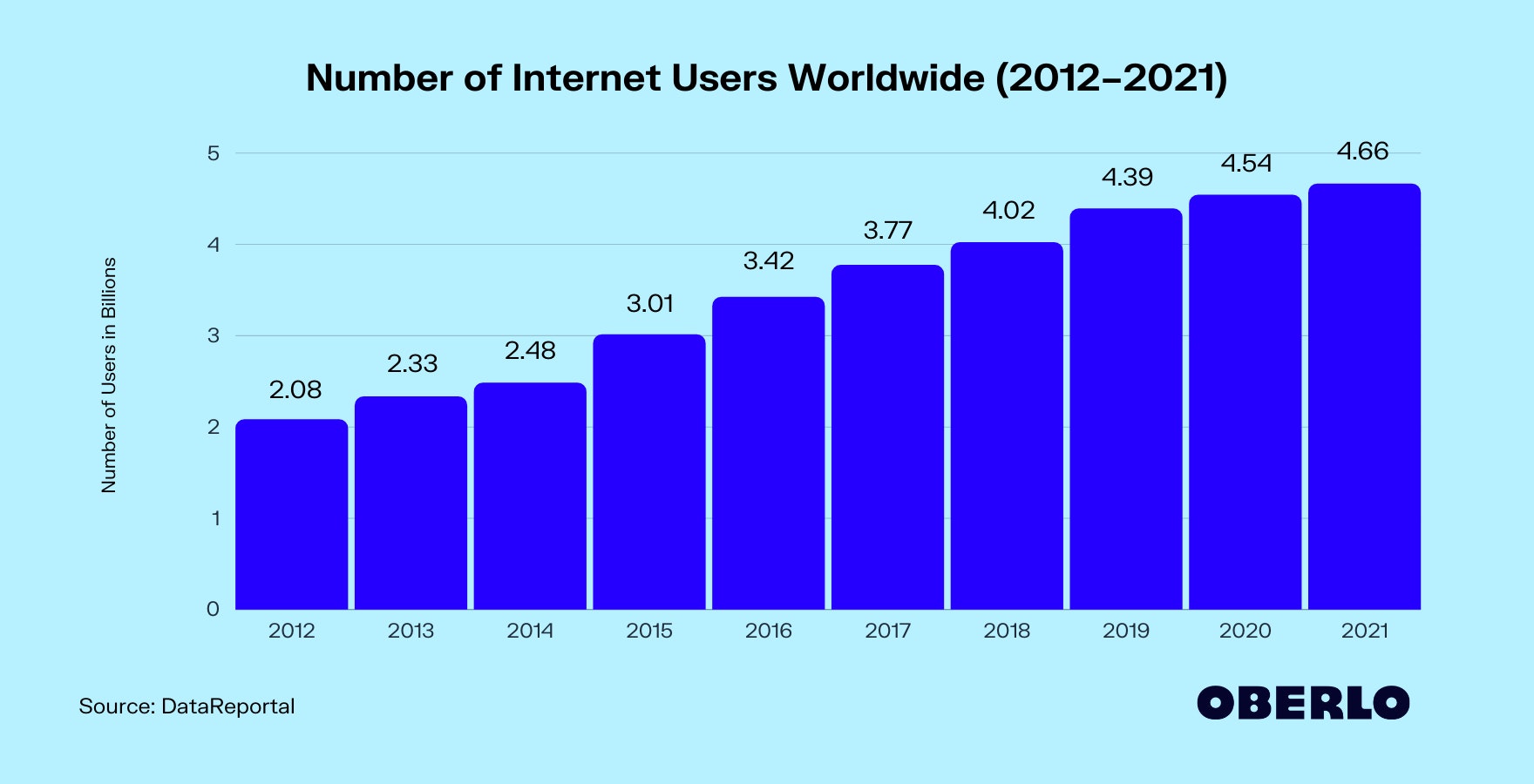
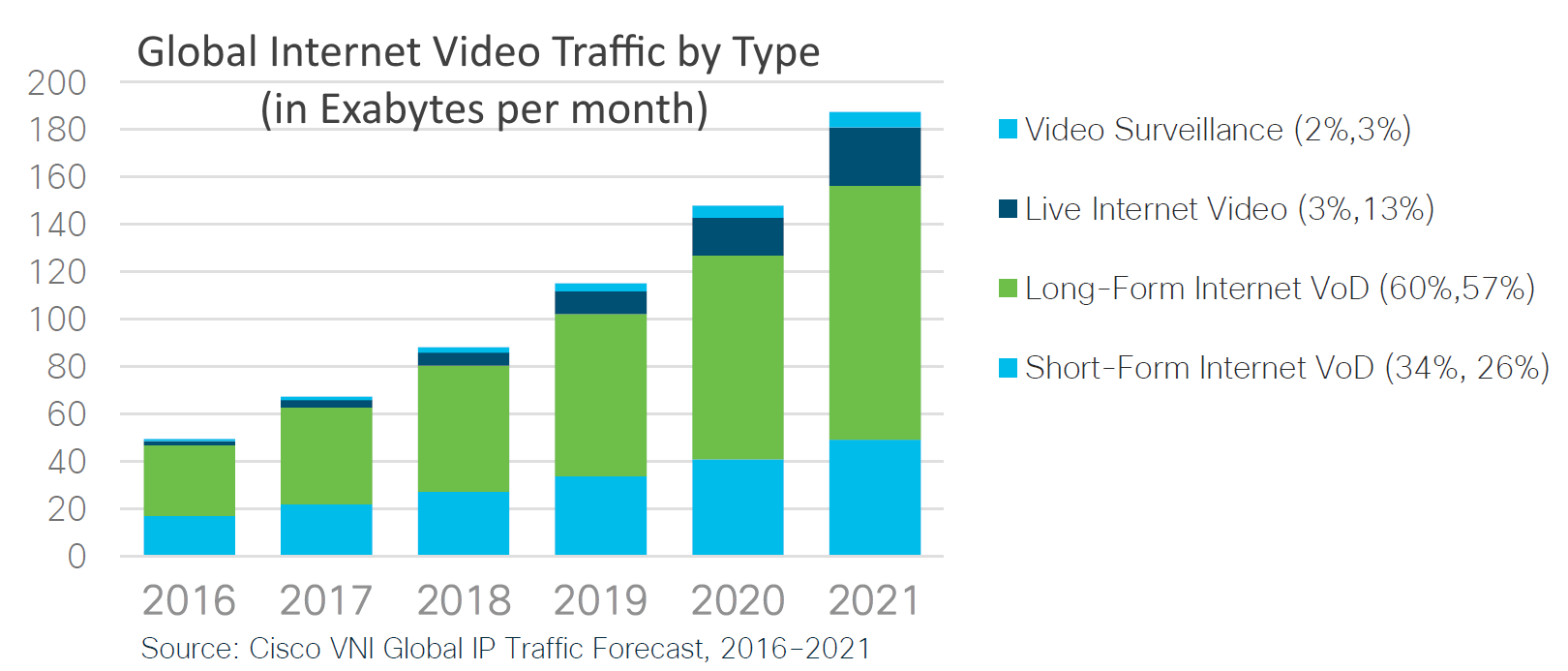
Side-note: video traffic is the majority of internet traffic.
How it really played out:
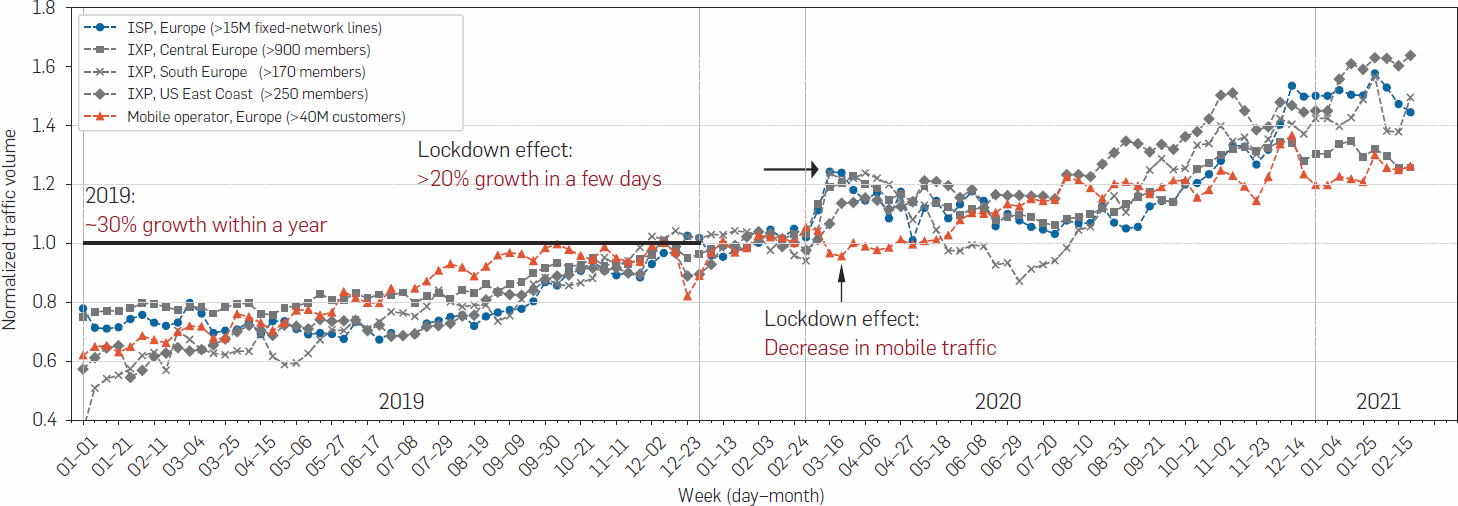
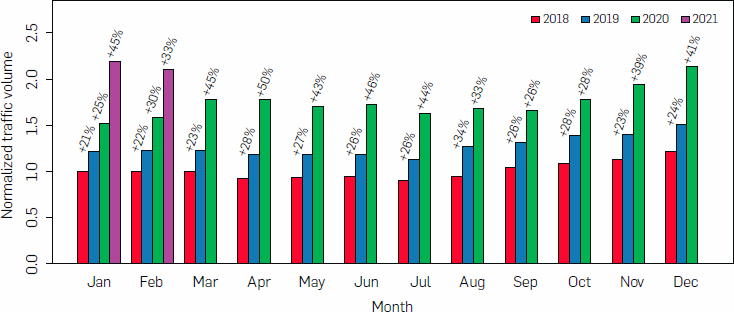
The whole paper: Inspiration/COVID_paper.pdf
According to some people, not as much as it could be:
“We wanted flying cars, instead we got 140 characters.”
- https://en.wikipedia.org/wiki/Peter_Thiel
“Men landed on the moon 50 years ago,
a tremendous feat of American creativity, courage, and, not least,
technology.
The tech discoveries made in the space race powered innovation for
decades.
But I wonder, 50 years on, what the tech industry is giving America
today.”
Or to put it another way,
“We wanted Mars colonies and all we got was infinite scrolling!”
- https://en.wikipedia.org/wiki/Josh_Hawley
Is there merit to this sentiment?
What have we built in 2025?
What is the most complicated machine ever build by humans?
Is the internet a singular machine, a singular system, a coordinated
system?
The computational power of this single “machine” is (by speculative
estimates)
is reaching the computational power of a single human brain,
which in case you are curious, is about 80-90 billion neurons.
For those who grew up on SciFi books, a living slime-mold of a
planet?
https://en.wikipedia.org/wiki/The_Singularity_Is_Near
https://en.wikipedia.org/wiki/Swarm_intelligence
https://en.wikipedia.org/wiki/Hive_mind
https://www.youtube.com/watch?v=k_GTIL7AECQ
A sense of intellectual freedom,
like a bike or a car for personal mobility.
What else does the global network provide?
When does being a slime mold make sense as a strategy?
When does it not?
It depends at least in part, on population size.
Perhaps we have we begun the internet’s neuro-degenerative old age of
the great:
https://en.wikipedia.org/wiki/Enshittification
This applies to platforms,
but search engines have experienced substantial collapse/decay via data
polution because of runaway optimization.
Do networked systems age?
Technical, organizational, regulatory, governmental, corporate?
https://www.reddit.com/r/Millennials/comments/1b301qj/the_internet_feels_fake_now_its_all_just_staged/
https://www.fromjason.xyz/p/notebook/where-have-all-the-websites-gone/
https://en.m.wikipedia.org/wiki/Splinternet
As countries attain autonomy, and cut off dependent ties to the outside
world, we see:
https://en.wikipedia.org/wiki/Balkanization
++++++++++++++++++++
Discussion question:
Do you think this is this good or bad?
Does it depend on who is asking the question?
Who is it good for?
Who is it bad for?